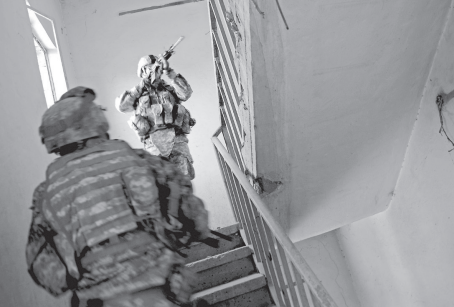Welcome to our Six Days in Fallujah Fire Team Mission guide! Six Days in Fallujah is a realistic first-person tactical shooter based on true stories of Marines, Soldiers and Iraqi civilians in the fiercest urban warfare since 1968. You can find the details about the fireteam mission in this adventure below.
Six Days in Fallujah Fire Team Mission
Welcome to our Six Days in Fallujah Fire Team Mission guide. In this guide, fire team missions, fire commands in the game and you will find basic fire departments!
U.S. Marine Fire Team
For this guide we will be taking a deep dive into the Fire Team element of a U.S. Marine Squad as it is the basis of the team in Six Days in Fallujah.
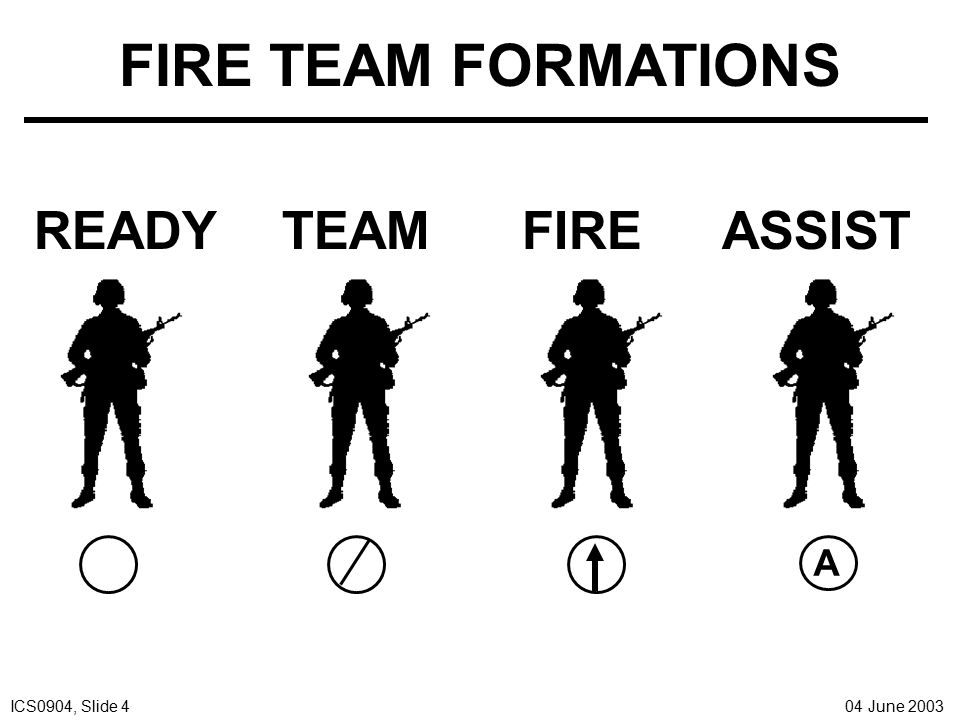
The U.S. Marine Fire Team can best be summarized as: Ready-Team-Fire-Assist, the arrangement of the team when in column formation. This should also be the order in which the fire team is stacked in. Ready is always point man and forward, Team Lead is right behind the Ready to direct the formation, Fire is right behind the Team Lead waiting for fire commands, and the Assist is pulling rear security.
Team Leader: They are responsible for the fire discipline and control of their fire teams, and for the condition, care, and economical use of their weapons and equipment. They take up the position that will best enable them to observe and control their fire teams. They are typically close enough to their automatic riflemen to exercise effective control of their fires. They additionally carry the M203 Grenade Launcher as the team’s Grenadier. (MCRP 3-10A.4, 1-3)
Automatic Rifleman (Fire): The automatic riflemen carry out the orders of their fire team leader. These riflemen are responsible for the effective employment of the automatic rifles (M249 SAW). Their responsibility during combat is to provide accurate and appropriately prioritized suppressing and assault fires to support the fire team leader’s scheme of maneuver and target precedence.
(MCRP 3-10A.4, 1-3)
Riflemen (Ready, Assist): The riflemen carry out the orders of their fire team leader. They are responsible for the effective employment of their rifles. Their responsibility is to deliver accurate rifle fire on the enemy in accordance with the fire team leader’s scheme of maneuver and target precedence. (MCRP 3-10A.4, 1-3)
- Ready: This rifleman is additionally tasked with taking point as the point-man, calling out targets as the fire team’s eyes or “scout”.
- Assist: This rifleman is additionally tasked with taking care of the fire team’s weak points. They carry additional ammunition and spot targets for the Automatic Rifleman (Fire), watch the flanks, or otherwise fill in gaps where the fire team is most susceptible.
Basic Fire Team Formations
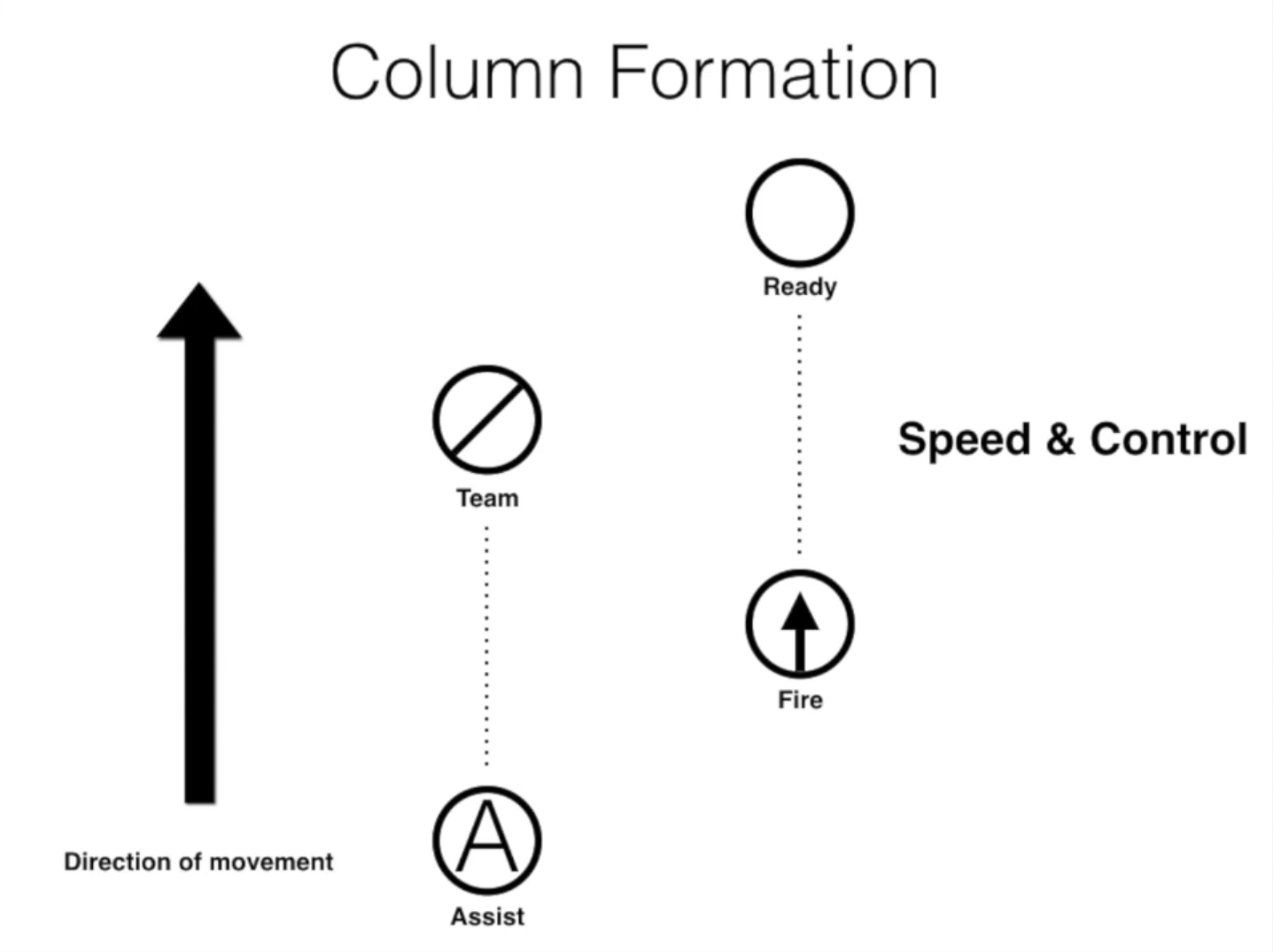
The Column Formation‘s characteristics are as follows: (MCRP 3-10A.4, 1-17)
- Permits rapid, controlled movement.
- Favors fire and maneuver to the flanks.
- Vulnerable to fire from the front and provides the least amount of fire to the front.
It is important to note that the column formation is meant to be used when moving through a secure area and at most only expecting contact from the left and right sides of the formation.

The Wedge Formation‘s characteristics are as follows: (MCRP 3-10A.4, 1-17)
- Permits good control.
- Provides all-round security.
- Formation is flexible.
- Fire is adequate in all directions.
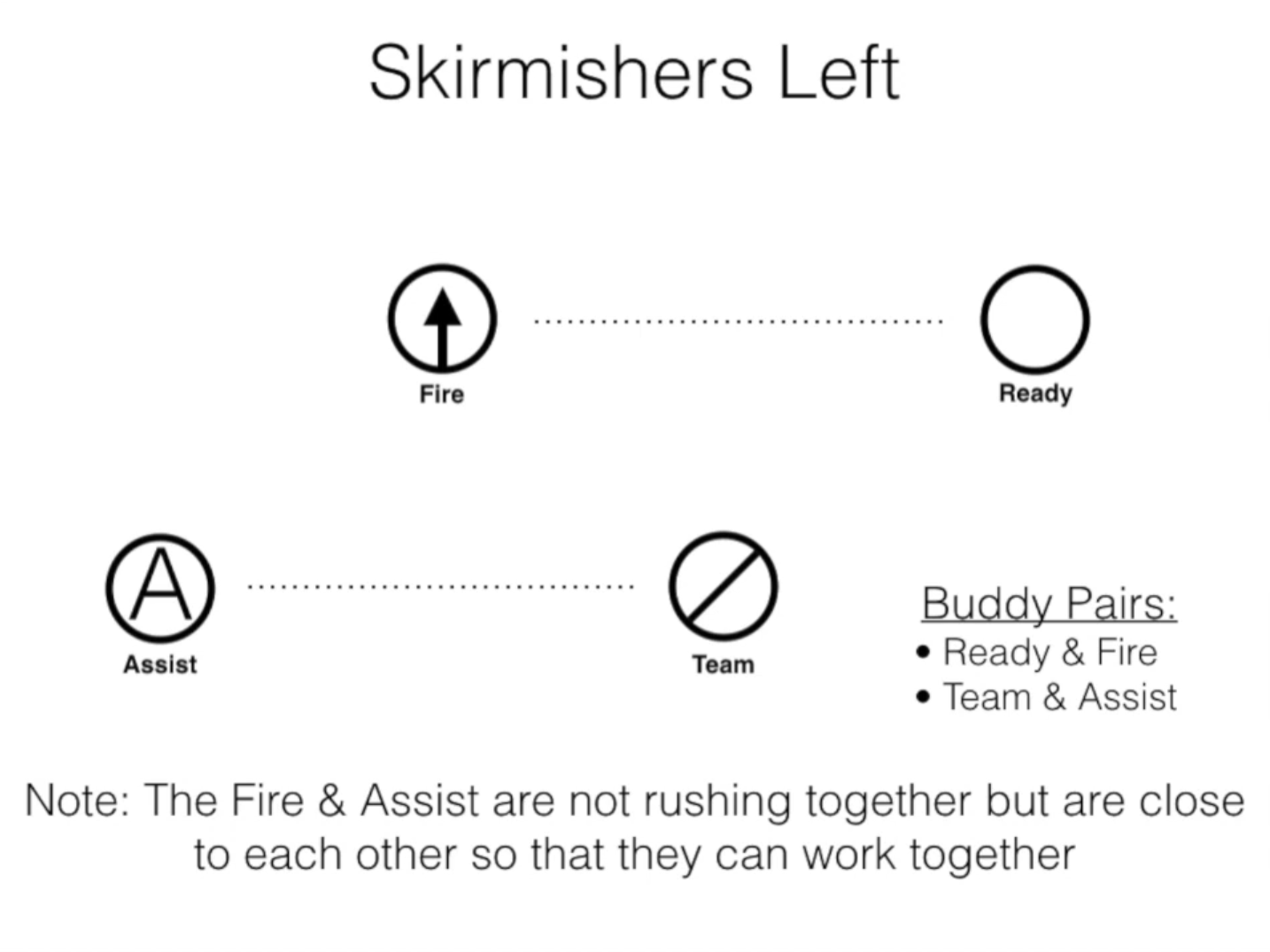
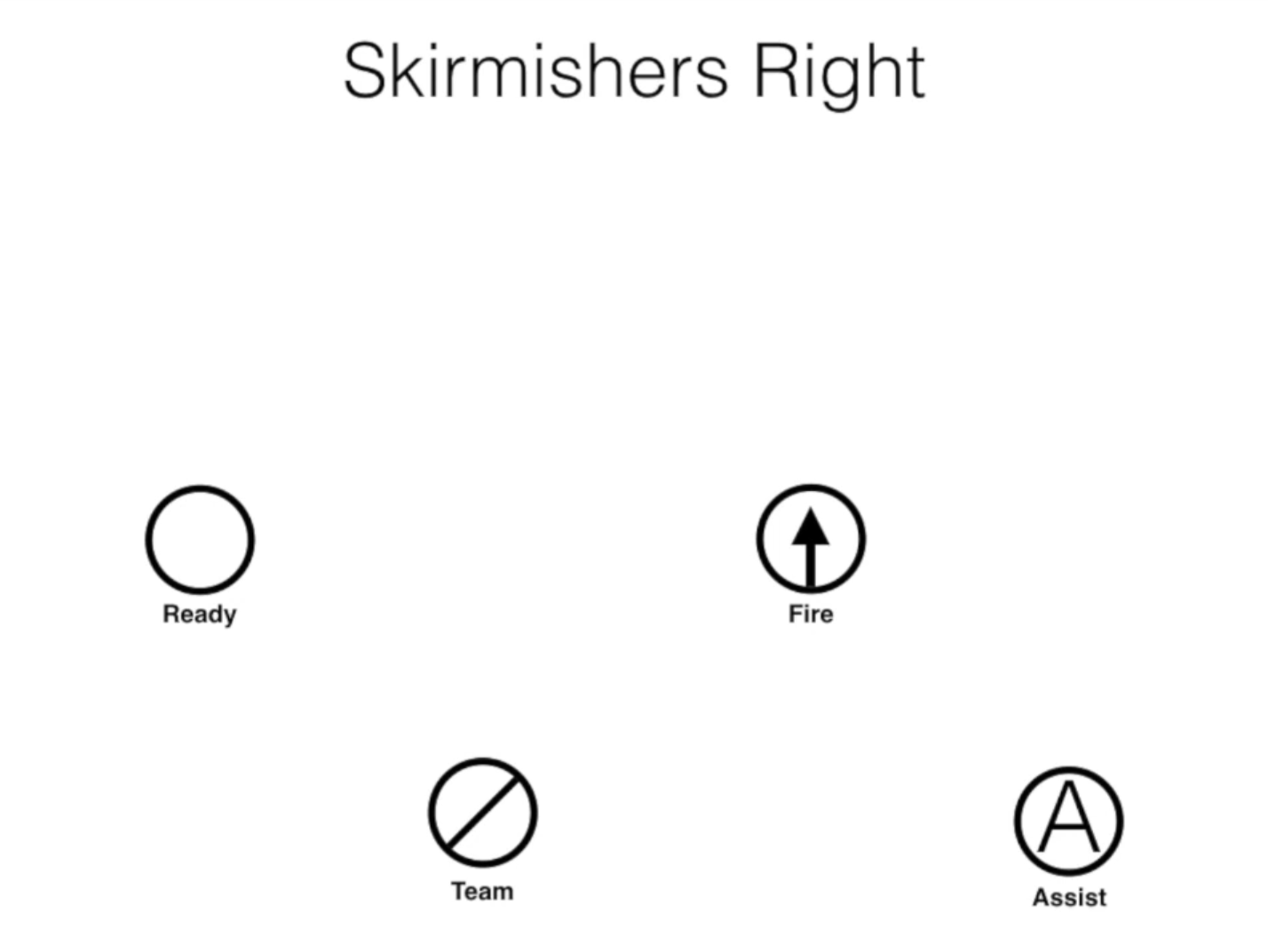
The Skirmishers Left/Right‘s characteristics are as follows: (MCRP 3-10A.4, 1-17)
- Provides the greatest volume of fire to the front.
- Used when location and strength of the enemy are known, during the assault and the pursuit.
- Movement in Combat: The fire team breaks up into pairs, with one pair covering the other with fires as the other pair quickly moves forward. *See Bounding
- Assaulting a Position: The skirmishers formation allows for a safer way to advance upon an enemy in contact while maintaining firepower.
Bounding:
Bounding is the form of movement used by Skirmishers Left and Right to move to an objective. The rear pair (Assist-Team) always rushes first, moving past the front pair (Fire-Ready) who are held in place and providing covering fire on enemy positions. This technique is repeated until the objective has been reached in a leap-frog like motion.
- When a pair is ready to provide covering fire and is no longer moving, they say “Set” over comms.
- When a pair is moving after the other pair has conveyed they are Set, they say “Moving” to warn the other pair that they are on the move.
- These two terms continue until the formation’s movement has been successfully completed.
Fire Commands
The following are the six elements that comprise the fire command and a description of each:
(MCRP 3-10A.4, 1-4)
- Alert: The fire unit is alerted to be ready to receive further information. The alert may also tell “who” is to fire.
- Direction: The general direction of the threat is given. When possible, the compass points or azimuth should be provided for direction.
- Description: The intended threat is described. I.E. “Contact with RPG”
- Range: Range information is given to set the sight or adjust the point of aim.
- Assignment: This identifies who is to fire on the threat and at what rate of fire.
- Control: Commanders signal to open fire.
Fire Command Example:
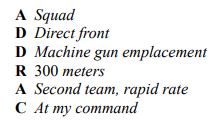
Subsequent fire commands are used by the team leader to change an element of the initial fire command or to cease fire. To change an element of the initial fire command, the team leader gives the alert and then announces the element to change. Normally, the elements that require changing are the assignment or control. (MCRP 3-10A.4, 1-5)
MOUT: Principles of Initiative
Military operations on urbanized terrain (MOUT) is a broad term referring to the many actions and considerations necessary in applying the fundamentals of warfare to the complex urban environment, (such as Fallujah). The basic tenets of fire team employment do not change because the squad enters urban terrain, and the fire team must train and adapt to urban terrain the same way it would to any other environment. (MCRP 3-10A.4, 6-1)
Principles of Initiative: (MCRP 3-10A.4, 6-2, 4)
- Security: The myriad potential for three-dimensional geometries of fire in urban operations precludes the team leader from accurately predicting all possible threats. Individual Marines must maintain high levels of situational awareness regarding the threat, the friendly force intent, and the operational environment, and take the initiative in covering fields of fire or adjusting positions to best mitigate the security threat to friendly forces. This is a continuing action, as both leadership and individual Marines must be constantly appraised of the effectiveness of security. Marines must be empowered to adjust their courses of action to account for emerging threats and the complexities of the urban environment.
- Surprise: Marines may utilize surprise to gain the advantage over an enemy through well executed stealth and tempo. Surprise may also be leveraged to take advantage of chance events on the battlefield, such as discovering previously unknown covered routes to an objective or identifying an unexpected enemy high valued target.
- Tempo: Speed is critical in urban operations, but not for the sake of speed itself. Rather than thinking in terms of speed, Marines should frame their actions in terms of comparative tempo between themselves and the enemy. Executing smooth, methodical, and effective tactical action at a tempo that exploits battlefield events faster than the enemy is more effective than risking effectiveness and security to beat an imagined clock. Marines should always remember the saying, “slow is smooth; smooth is fast.”
- Accuracy: Due to the compartmentalized nature of urban terrain, it is easy for Marines to become disconnected from battlefield events, regardless of their relative proximity. It is the responsibility of every Marine to ensure that a shared situational awareness is maintained throughout tactical actions. Clear, concise commands and reports should be utilized early and often.
- Violence of Action: Urban combat is often fast-paced, confusing, and frantic. The principle
violence of action means that Marines engaged in urban combat must take the necessary actions to maintain the initiative once in contact. Accurate fire, aggressive movement and maneuver, and shock effects such as explosive breaching and clearing should be utilized to establish and maintain dominance on the urban battlefield. - Identify and Cover Danger Areas: Any area that has not been cleared or cannot be confidently determined to be clear of threats is considered a danger area. This includes areas previously cleared but left unoccupied. Marines must be able to identify danger areas as they arise and ensure they are adequately covered. Marines should not give up covering their danger areas until relieved by other Marines, or until the unit moves beyond the potential impacts of the danger area.
- Accurately Engage Threats: The importance of differentiating between threat and friendly forces or civilians must be in the forefront of every Marine’s mind before employing any weapon. Once threats have been accurately identified, Marines can then accurately and purposefully employ their available firepower.
MOUT: Exterior Movement
Bump Method
In the bump method, every member of the fire team trades the holding of the danger area until they have physically “bumped” past, continuing down the line until the team has made it across.
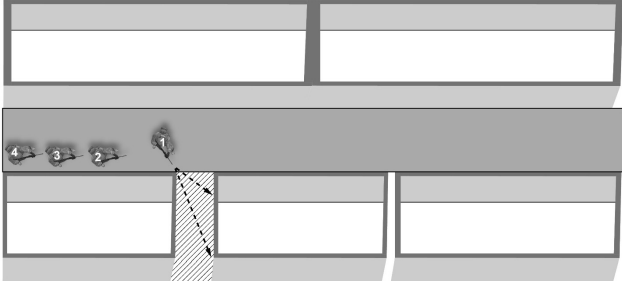
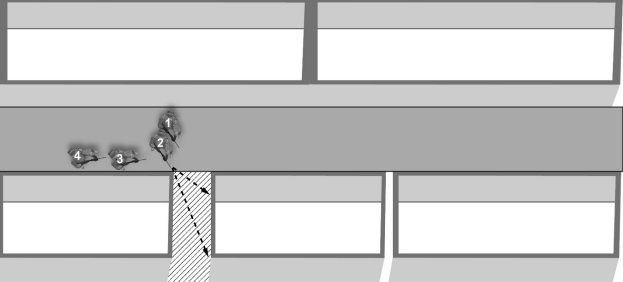
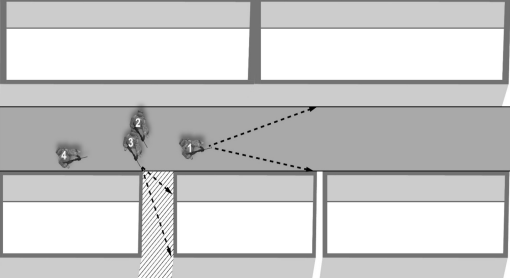
Bound Method
This method differs from the bump method, in that after the number one Marine identifies the danger area and establishes security, the remaining team members all move past the number one Marine and continue on the route. Once they have passed the number one Marine, that Marine assumes the position of rear security for the team.
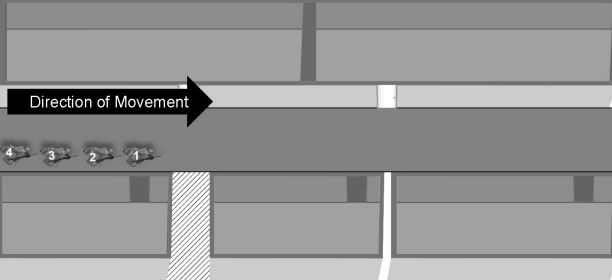
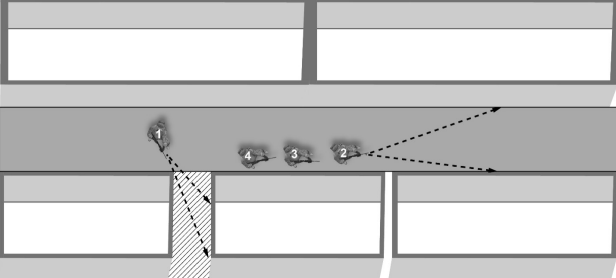
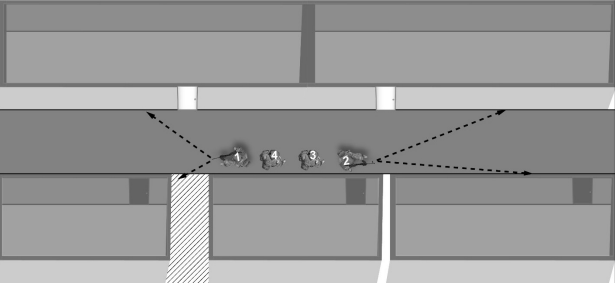
MOUT: Exterior to Interior
To transition from exterior to interior movement
or to otherwise gain entry to a hostile or
potentially hostile emplacement, Marines use the
urban attack cycle—reconnoiter, isolate, gain a
foothold, seize the objective, and consolidate and
reorganize. The cycle begins at a
covered position. (MCRP 3-10A.4, 6-16)
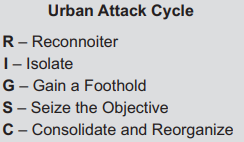
- Reconnoiter: Prior to making entry, Marines use whatever means are at their disposal to gain more information on their target. This may range from small unmanned systems (i.e., either aerial or ground) to a cursory map and visual estimation. Marines must identify their preferred and alternate points of entry to the target area prior to continuing the urban attack cycle.
- Isolate: Marines use various methods to isolate the target area from outside influence to set the conditions for seizing an entry point. In more hostile environments, this is generally accomplished by posting security to cover the flanks of the intended route of movement to the objective and deploying obscuration to mask friendly movement. In more permissive environments, this may be establishing an outer cordon around the objective with a security element.
- Gain a Foothold: Marines aggressively and violently dominate the entry point to the objective and penetrate any defensive obstacles using whatever means available—through explosive or mechanical breaching or close combat—to secure the initial foothold in the objective area. In more permissive environments, this means Marines should have absolute positive control over the entry point to the objective. The first cleared area in the objective generally becomes the initial rally point for casualties, reinforcements, and captured personnel and materiel to flow through. Once this entry point is gained, it is relinquished until directed otherwise.
- Seize the Objective: Gaining a foothold is often the most violent and frantic portion of the urban attack cycle. Once a foothold is established, Marines should methodically clear the objective.
- Consolidate and Reorganize: Though included together, consolidation and reorganization usually happen as two separate stages. This phase begins with the immediate actions to repel potential counterattack and includes consolidating the objective area and reorganizing for follow-on tasks. By setting limited objectives, the attacking force has an opportunity to reorganize and defend against counterattack while maintaining momentum.
MOUT: Clearing Fundamentals
Interior Clearing Commands: (MCRP 3-10A.4, 6-18)
- Stack: Refers to a team or unit ready to make entry. A stack can be made up of any number of Marines. This term is also used as a verb to direct a number of Marines to a specific location within the objective. After initial entry has been made and a foothold has been established, “stack” will be announced to bring the remainder of the fire team into the objective. During the assault, it may be necessary to direct an element to a specific location within the objective (e.g., Team one, stack on me).
- Support: This command is used to draw attention to members of the fire team who need assistance. When used alone (e.g., Support), only the support of one additional Marine is necessary. If more than one Marine’s help is necessary, then the number of Marines needed should be given after the command (e.g., Support, two or Support, three).
- Closing: Lets others know they are moving in depth or forward into the kill zone. It is usually given from a dominating position after the threat has been eliminated (e.g. when checking dead enemy). The other Marines within the enclosure adjust their sector of fire to support this action.
- Hold: The command, Hold is used to stop all actions within an enclosure and address a specific situation that could place fellow Marines in danger (e.g., a possible threat, danger area, dead space, or check to ensure whether suspected enemy dead are actually dead or not).
- Shot: This command is announced forcefully when a shot must be taken down the length of a hallway. This alerts others NOT to enter the hallway until they hear the command, Continue.
- Continue: Given only after the commands, Shot and Hold. This tells Marines they may
continue with their actions. - Danger area: This command identifies areas of concern for security purposes.
- Turn and go: This command relieves a Marine from a security position
- Last room: This command informs the fire team that the limit of advance (i.e., the last room and location in a section of the objective) has been reached (e.g., Last room, first deck).
- Landslide: Directs all Marines to make rapid, controlled movement to a consolidation point
- Avalanche: Directs all Marines to immediately evacuate the target site by whatever means
available and move to a designated rally point outside of it. This is used only in emergencies, such as if a Marine discovers the structure is rigged to explode.
Rules of Room Clearing: (MCRP 3-10A.4, 6-19)
- Never clear with a Marine what could instead be destroyed with high explosives.
- When able, prepare all rooms with fragmentation prior to entry.
- Never clear a room alone.
- Avoid throwing grenades up a staircase.
- Not all walls afford equal protection; know what cover is available in the urban environment.
- Take accountability upon entering and exiting each room.
- Never stack in open exterior areas.
- Overwatch walled compounds prior to entry
- As soon as there are no eyes on a room or structure, it cannot be assumed to be clear; back
clearing may be necessary. - Urban fighting is three-dimensional—clear right, left, upward, and downward
Standard Clearing Sequence: (MCRP 3-10A.4, 6-19, 22)
- Clear as much of the room as possible from the exterior: Marines should use the building’s geometry to their advantage by employing the “pie method” to limit their exposure to danger areas while methodically clearing threats from the objective.
- Clear the fatal funnel: The entryways to rooms, hallway junctures, and breach points are natural aim points for defending adversaries. When making entry, Marines must aggressively move past this “fatal funnel” of incoming fire.
- Dominate the room: Upon entry, seek out and secure dominant positions that offer the best
coverage of the room and ensure they have open and interlocking fields of fire. - Eliminate threats: Systematically neutralize threats in the room through violence of action.
- Control the room: The senior Marine dictates follow-on actions once threats have been eliminated. No further movement through the room is authorized without the fire team leader’s approval.
- Hasty search: Search the living, search the dead, search the room.
- Mark: The room is marked to indicate it was cleared and searched according to the unit’s SOPs. However, if a space is marked and no Marine has had constant observation on it, it must be recleared if the unit intends to traverse it again.
- Evacuate: The fire team gains accountability and leaves to continue clearing the building.
MOUT: Clearing Techniques
Single Room Clear: (MCRP 3-10A.4, 6-20, 21)
- When clearing a single room, the number one Marine in the stack identifies a room that has not been cleared and “pies” off the entryway a step at a time, thus clearing the room from the outside. Once as much observation of the room as possible has been gained from the outside, the Marine enters and goes to the least observed corner of the room. The number two Marine follows through the doorway close behind and moves toward the opposite direction, then orients on the center of the room or the next area that cannot be observed.
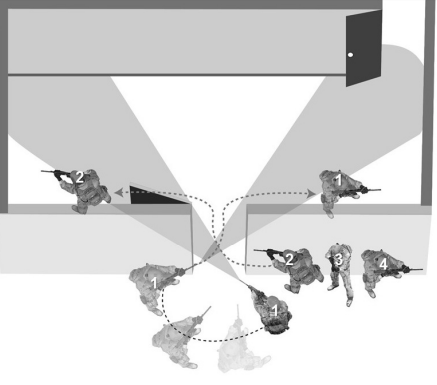
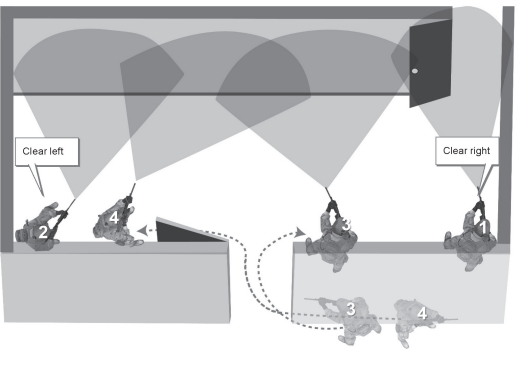
L-Shaped Hallway Intersection: (MCRP 3-10A.4, 6-23 – 26)
- If an L-shaped hallway is encountered, Marines use similar principals to room clearing. The number one Marine calls out the hallway once they recognize it and stops the forward motion of the stack just short of the hallway turn, taking care not to let the body or rifle barrel protrude past the hallway corner.
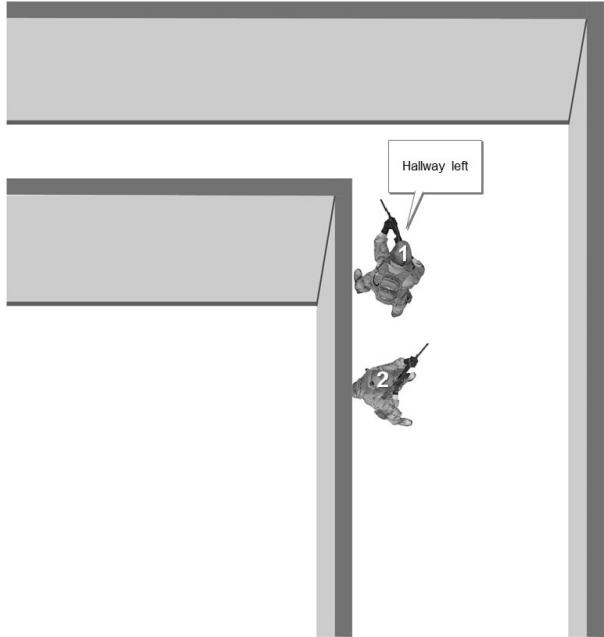
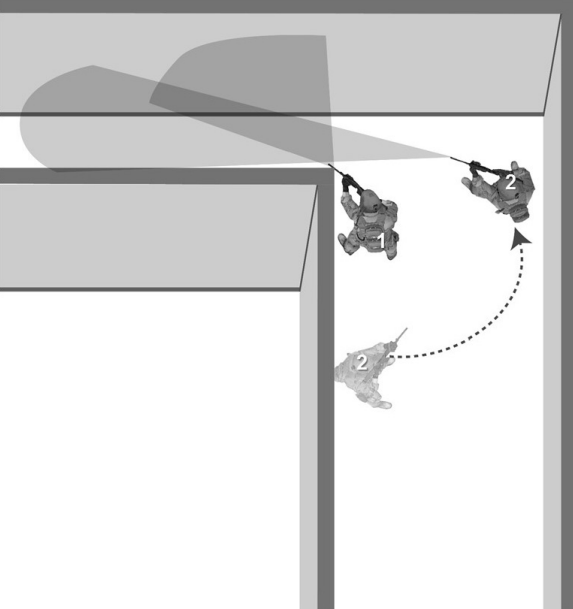
Dominating a Hallway: (MCRP 3-10A.4, 6-27)
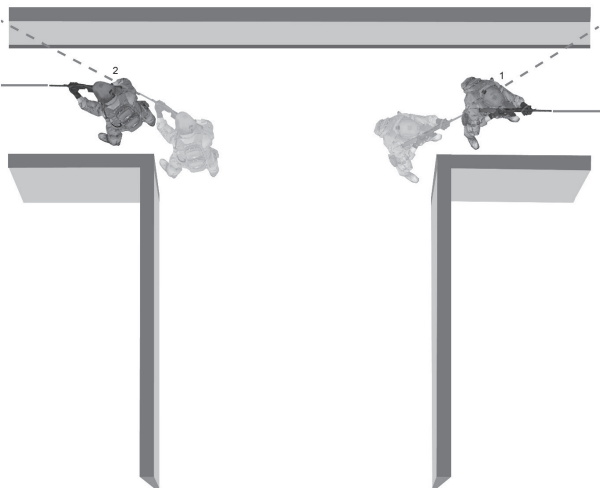
Clearing Stairwells: (MCRP 3-10A.4, 6-27, 28)
After entering a building, the fire team may encounter stairwells. Stairwells are the most difficult areas of a building in which to operate. Knowing the building construction would give the fire team a significant advantage in determining which technique to use when clearing a stairwell. There usually two types of stairwells—continuing and noncontinuing. The following procedures are used for clearing them:
Continuing: Continuing stairwells (i.e., switchbacks) are typically on the ends or at the corners of buildings, and usually close to elevators. Continuing stairwells should be cleared in segments by “bounding” rapidly between landings while maintaining security under landings, overhead, and to the front and rear. Teams move progressively up or down the stairway levels. Once a flight of stairs has been cleared, the clearing team stops to maintain security on the door and to the front. The next team then assumes the assault team role and clears the next flight of stairs. This is repeated until the top or bottom floor is reached.
Noncontinuing: Noncontinuing stairwells end after the first flight of stairs reaches the next floor. To clear, the number one Marine leads up or down the stairs, one step ahead of the number two Marine. Upon reaching the point just before it is possible to be engaged from above or below, number one Marine turns around and covers overhead. From this point, the number one Marine ascends the stairs, moving backward while covering behind and above. The number two Marine follows the number one Marine upstairs, one step behind and to theside. When the number one Marine turns to cover overhead, the number two Marine remains oriented to the front, covering directly up the stairwell. The clearing team’s speed of movement is determined by the number one Marine. Marines pie as much of an area as possible before ascending each step.
